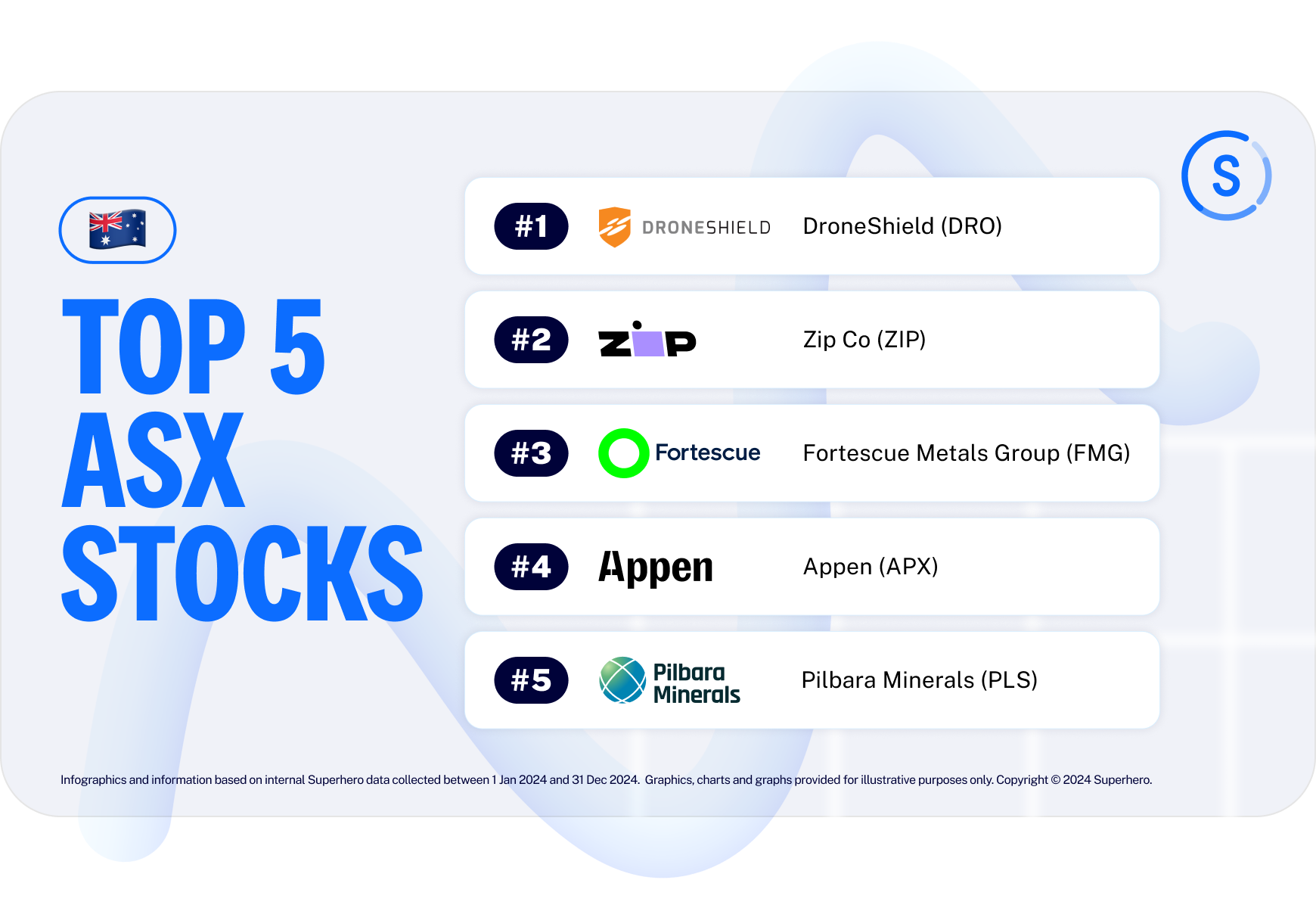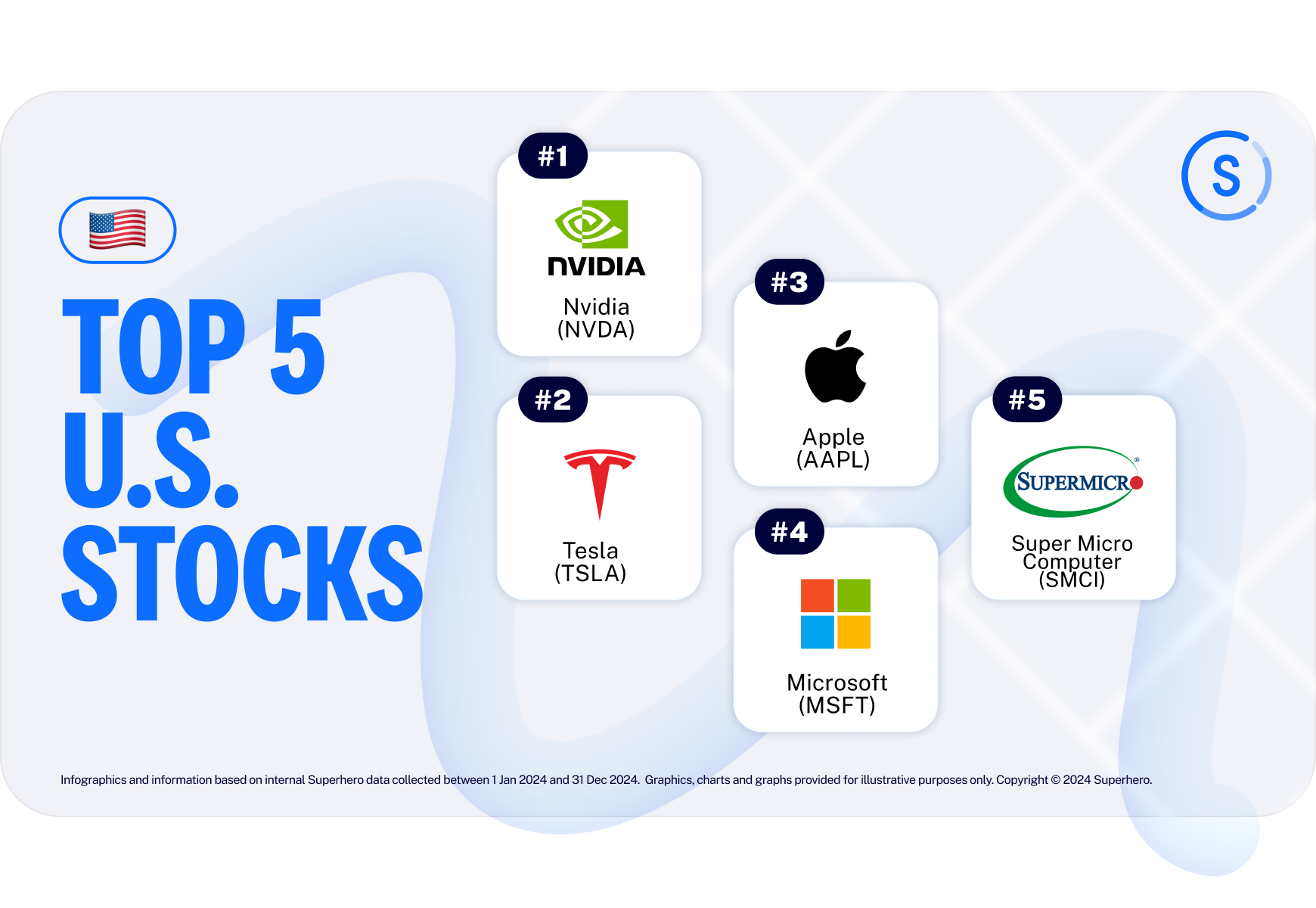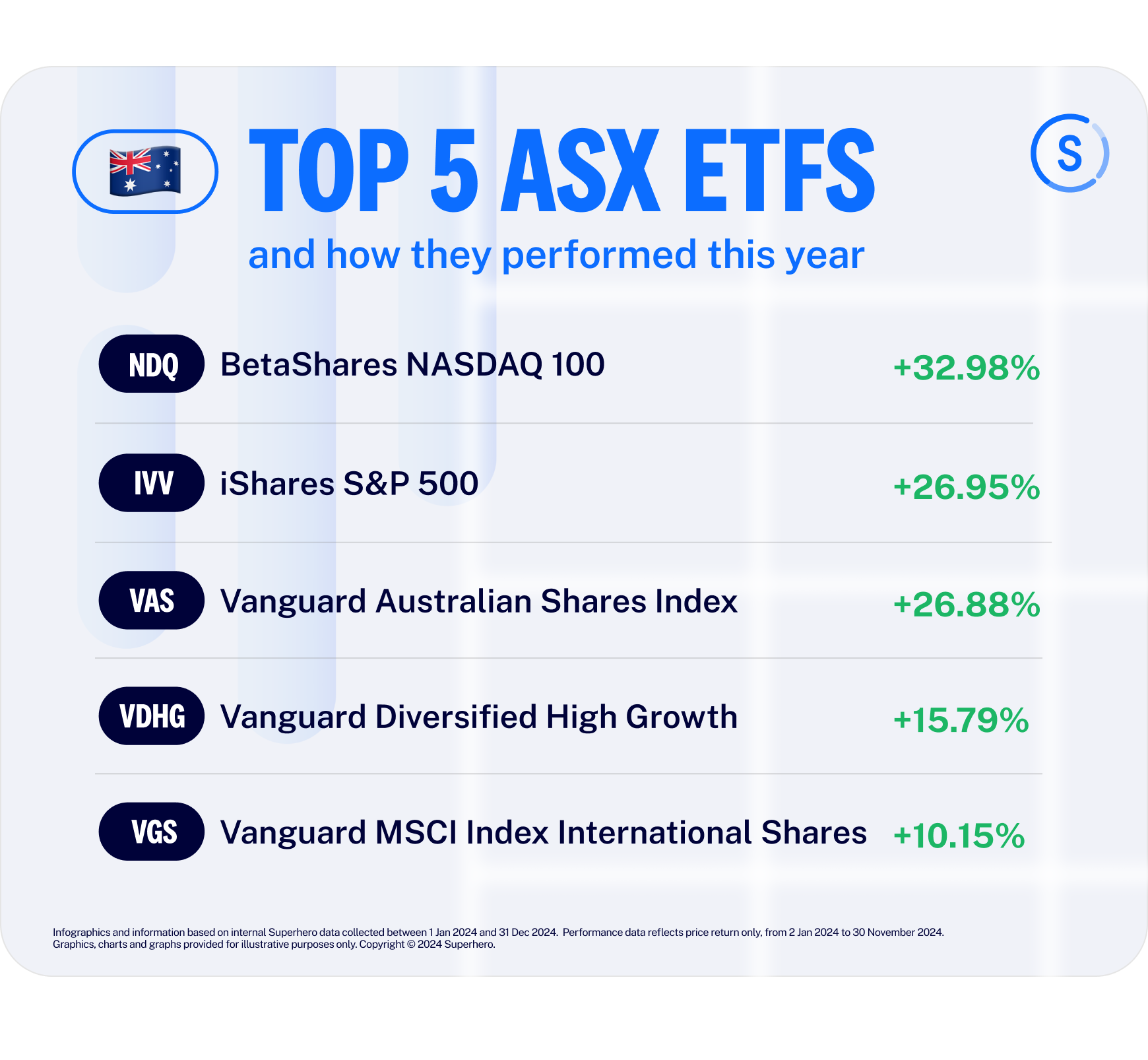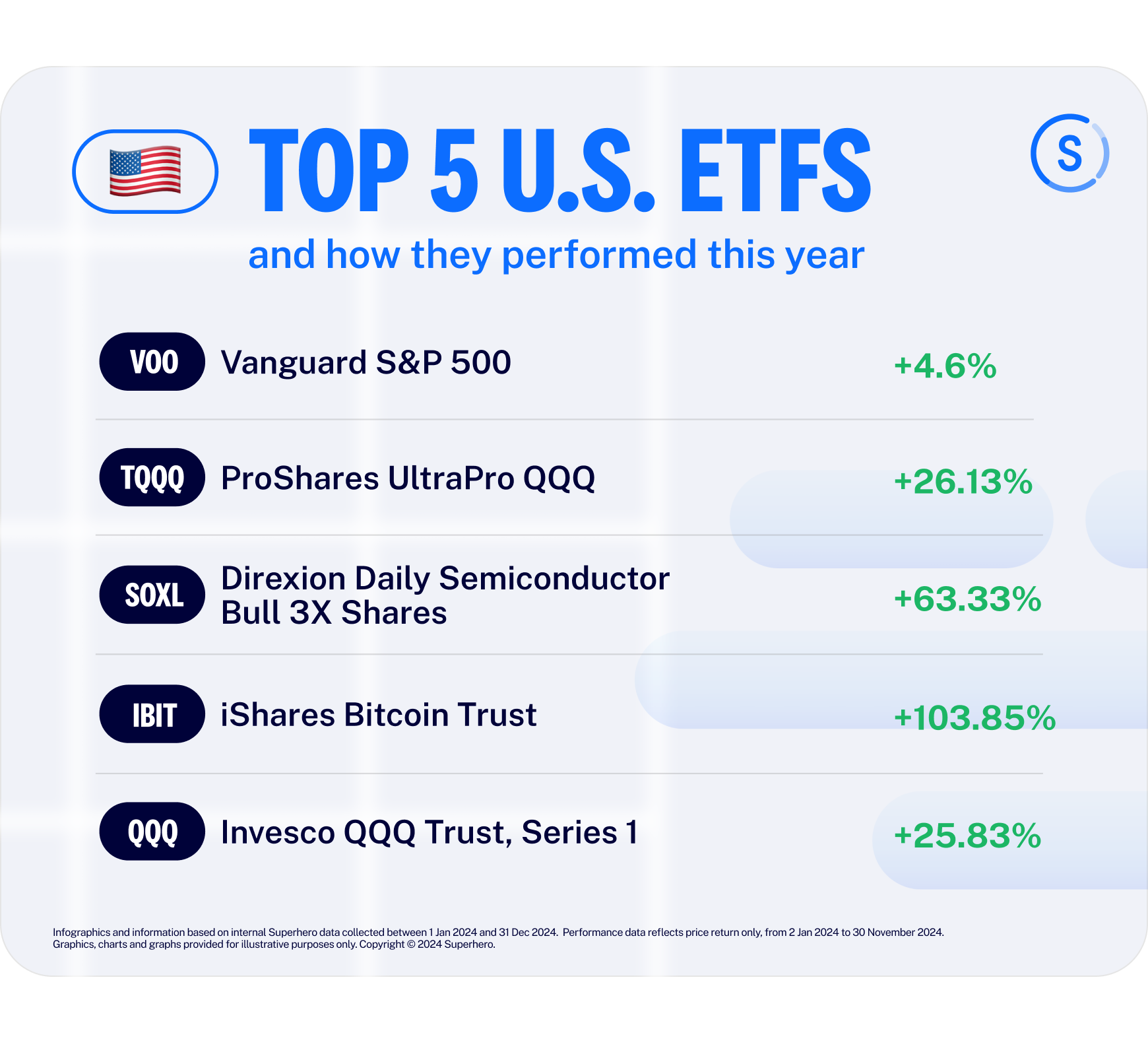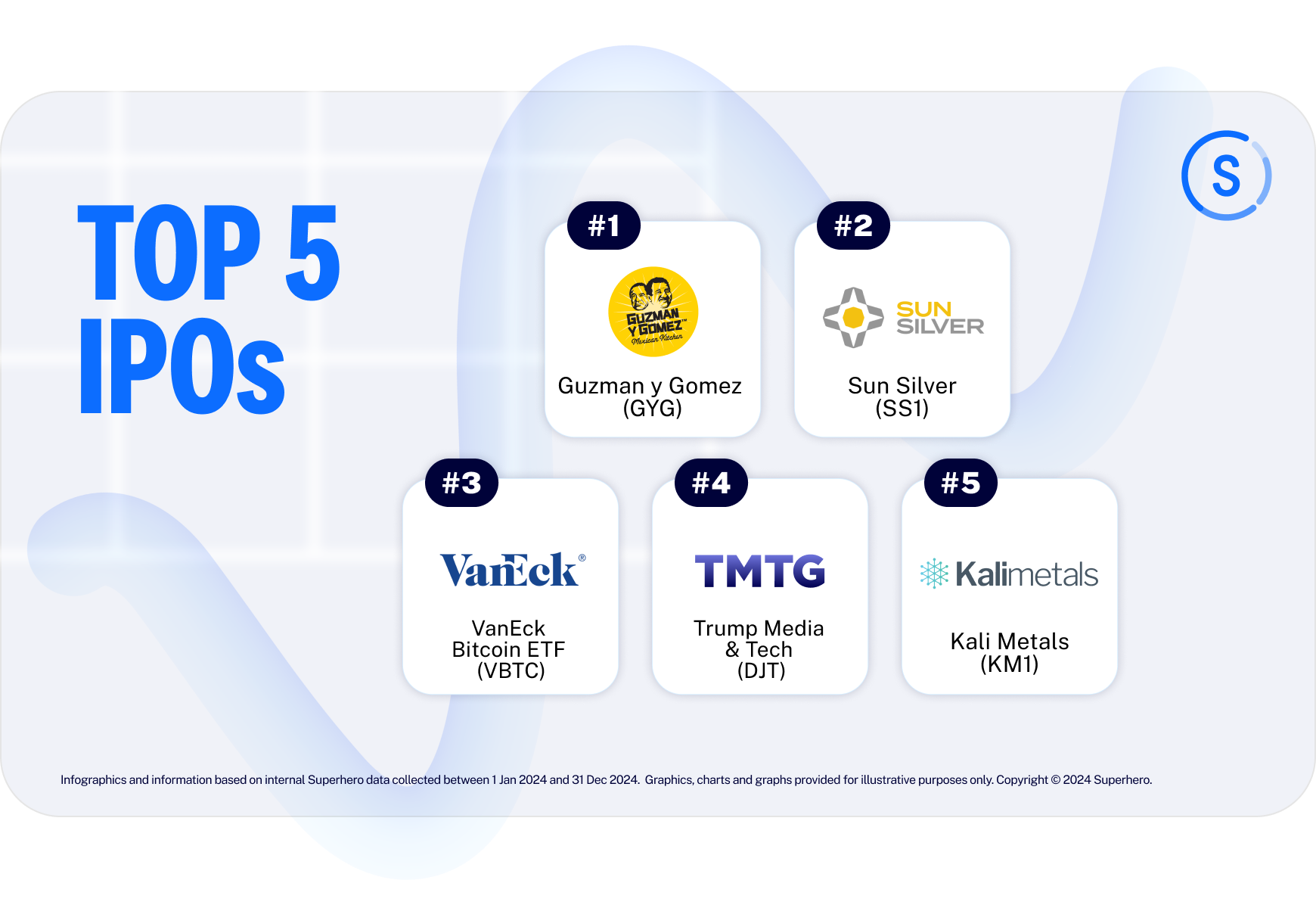Scan this article:
Did you know that the S&P 500 closed at a new all-time high an incredible 57 times this year? That’s the fifth-highest number of record closes in a single year since 1929!
Overall, this is how the markets performed this year:
- S&P 500: +24.5%
- Nasdaq: +32%
- Dow Jones: +12.9%
- ASX 200: +7.3%
What a year it’s been for investors! Before we close the chapter on 2024, let’s take a moment to reflect on the events, stories and lessons that can guide us moving forward.
Warmly presenting to you: Superhero’s Year in Trades 2024.
A move back to risk-on investments on the ASX
Last year, we saw investors flock to Aussie ‘blue chips’ such as Commonwealth Bank of Australia (CBA.AU) and ANZ (ANZ.AU) as inflation and interest rates remained persistently high. Moving towards companies with larger market capitalisation and longer history on the markets signals a shift towards a more defensive investing approach.
While the RBA cash rate remained at a 13-year high of 4.35% this year, investor sentiment appears to have finally adapted. 2024 saw a broader move towards riskier and more volatile stocks like DroneShield (DRO.AU), Zip Co (ZIP.AU) and Appen (APX.AU) — reflecting a sense of renewed investor confidence and risk appetite.
How and why did Droneshield capture investor interest?
Read our Deep Dive on Droneshield to learn more.
Another noteworthy change in this year’s top traded was the shift in investor interest away from lithium miners. We saw the likes of Pilbara Minerals (PLS.AU), Core Lithium (CXO.AU) and Sayona Mining (SYA.AU) dominate 2023’s popularity list, but it looks like subdued lithium prices discouraged investors from going as hard into the sector this year. Lithium commodity prices are currently down over 20% year-on-year.
In contrary, interest in iron ore miners including Fortescue Metals Group (FMG.AU) and BHP (in #6) remained high despite iron ore prices weakening even further than lithium prices this year. This is likely due to two main factors: iron ore being Australia’s largest export and China – Australia’s top importer of iron ore – unveiling its massive stimulus packages set to bolster Chinese infrastructure growth.
Tesla’s three-year record has been broken
For the last three years, Tesla had taken the top spot – the highly coveted, highly elusive, #1 most traded stock on Superhero.
This year, things are looking a bit different.
Nvidia skipped past not just Tesla but Apple too – claiming first place as its shares rocketed over 190% in 2024 alone! It stole some of the spotlight away from Palantir (PLTR.US) and C3.ai (AI.US), who were amongst the most popular AI stocks last year.
Aside from now being one of the most-loved stocks on Superhero, Nvidia had also gone head-to-head with Microsoft and Apple in claiming the title of largest publicly traded company in the world.
How did Nvidia grow so fast this year?
Read our Deep Dive on Nvidia to learn more.
ASX-listed but make it Wall Street
Like 2023, index-tracking ETFs were the most popular. But unlike 2023, ETFs that tracked the U.S. markets took the top spots for our most traded ASX-listed ETFs. VAS, which tracks the performance of the ASX 200, fell down to #3.
Investor interest in U.S. markets expanded immensely this year thanks to the U.S.’ large exposure to the artificial intelligence sector and the strength of the U.S. Dollar. The U.S. Federal Reserve had also cut interest rates by a total of 100 basis points this year, further bolstering its local economy.
Wall Street indices (i.e. S&P 500 and Nasdaq) overall outperformed the ASX index this year.
Some Riskier ETFs for Wall Street
Spot Bitcoin and Ethereum ETFs both made their debut on Wall Street this year – a year where cryptocurrency saw a massive recovery from 2022-2023 lows, and where Bitcoin hit its milestone of being worth US$100,000 for the first time in history.
Perhaps it’s unsurprising then that the iShares Bitcoin Trust (IBIT.US), one of this year’s new Bitcoin ETFs, made it to the top five.
Like last year, Superhero’s top traded U.S. ETFs were index-tracking ETFs that tracked the S&P 500 and Nasdaq-100, respectively.
The other two on the list are the riskier leveraged ETFs. SOXL, for example, tracks the performance of the 30 largest U.S. semiconductor companies and uses leverage to multiply its daily returns by 300% – both positive and negative. Similarly, TQQQ also multiplies the daily performance of the Nasdaq-100 index three times.
Year of the IPOs
Aussies displayed a heightened risk appetite this year, driving higher trading activity in riskier stocks and ETFs.This surge also contributed to a higher total IPO deal value in 2024 – surpassing the combined totals of 2022 and 2023.
Similarly, we saw Superheroes become increasingly interested in some of Wall Street’s newest listings.
Cult-favourite Guzman y Gomez (GYG.AU) took this year’s top spot after strong retail interest that saw its IPO heavily oversubscribed. GYG captivated investors with its inspiring Aussie growth story and its ambitious goal of expanding across the globe. It’s ending this year up almost 40% since its IPO just half a year ago.
Is Guzman y Gomez really worth the hype?
Let’s deep dive into its financials and growth plans to see how it garnered the love of investors.
The most popular IPO for Wall Street was, on the other hand, President-Elect Donald Trump’s very own Trump Media & Tech (DJT.US). The company operates “Truth Social,” a social media platform that looks strikingly similar to Twitter. Interestingly, it was founded soon after Trump infamously got booted off mainstream social media platforms back in 2021. DJT celebrated a stunning Nasdaq debut back in March and saw a massive surge in trading activity when Trump won this year’s U.S. Presidential Elections.
Another highly popular social media platform that made it to the Nasdaq this year was Reddit (RDDT.US), which landed in #7.
What should investors expect for 2025?
With 2024 being a bullish year for markets, investors and analysts alike will be keeping an eye out for 2025. The below sections are some areas of interest.
Australian federal election
Australia’s next federal election is scheduled for sometime around May 2025, which may lead to amendments of the current fiscal and monetary policies.
There may also be changes in infrastructure, energy and real estate plans which can have a follow-on effect on Australia’s broader economy and listed companies in those sectors.
Interest rates
The Reserve Bank of Australia (RBA) maintained the cash rate at 4.35% this year, standing firm despite countries like the U.S., EU, Switzerland and Canada moving to cut rates.
As of 30 December, the futures market has priced in three rate cuts from the RBA next year. Meanwhile, the Federal Reserve has signaled plans for two rate cuts in the U.S. in 2025.
New U.S. President
Global markets are also expected to be swayed when President-Elect Donald Trump gets inaugurated on 20 January 2025.
Trump’s key policies are known to be centered on the concept of “America First,” where he is expected to raise import tariffs and taxes on foreign goods, crack down on illegal immigration and focus on growing America’s domestic economy. Similarly, Trump is a known advocate for cryptocurrency adoption.
China’s Economic Stimulus
Another key area Aussie investors should look out for is the economic effect of China’s stimulus package unveiled earlier this year. China is Australia’s number one trading partner, with the former being a large importer of Australia’s commodities, fuel, meat and wine, amongst several others.
The stimulus package is expected to inject trillions of yuan into the Chinese economy, with hopes that it’ll bolster the weakening real estate and infrastructure spend.

Become a part of
our investor community
Why you should join us:
- Join free and invest with no monthly account fees.
- Fund your account in real time with PayID.
- Get investing with brokerage from $2. Other fees may apply for U.S. shares.
Read our latest articles
Make knowledge your superpower and up your skills and know-how with our news, educational tools and resources.



